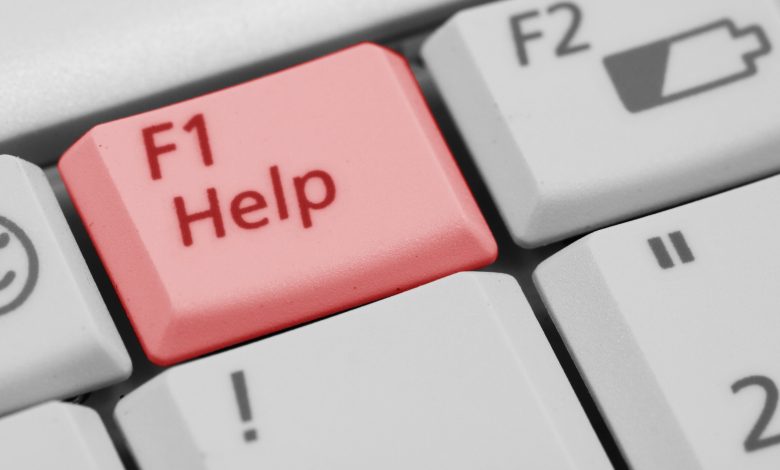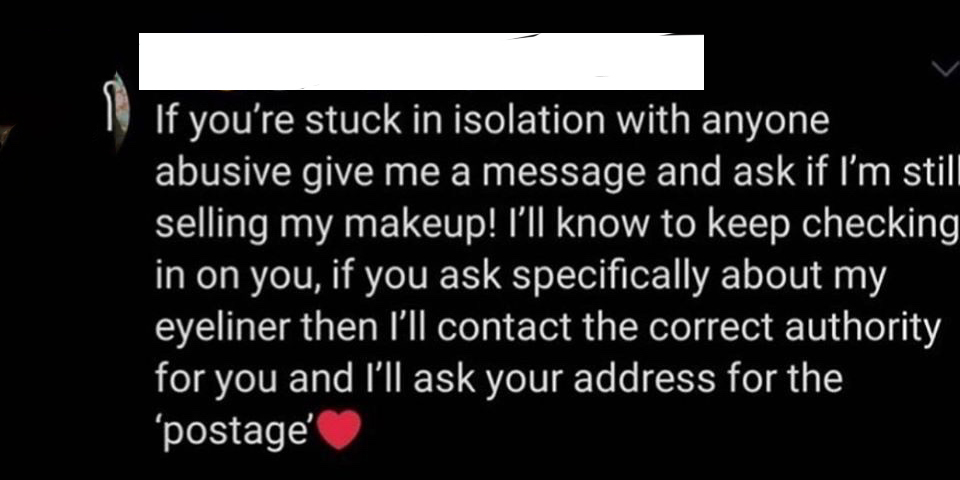Lemon Cakes and Eyeliner
Using Social Media to Combat Domestic Abuse during a Pandemic

Content Note: This post includes discussion of domestic abuse and stories of survivors of abuse.
Living through a global pandemic is a strange and frustrating thing. For those of us lucky enough to be able to work at home without major financial or physical implications, these days are a bizarre combination of extreme boredom and extreme anxiety.
For me, one of the most difficult things to overcome has been the sense of helplessness. We read every day about the doctors, teachers, pharmacists, grocery store workers and other essential workers who are literally risking their lives to keep our society functioning and the best and most important thing for us to do to support them is nothing. Stay home, stay away, keep out of it. So it’s only natural that we grab on to any opportunity to feel like we are helping in a more tangible way.
There has been quite a bit of media attention around the problem of domestic abuse and the escalated danger and concerns around victims who are having to shelter-in-place with their abusers. The Huffington Post recently had a heartbreaking article written by a survivor who has had to place her plans to leave on hold and stay with her abuser until the stay-at-home order is lifted.
To the outside world, when I post on social media or buy groceries, which has become my only public outing now, I may seem to exude happiness. However, I am constantly nervous about what I or my children will do that could anger my husband. How can I keep him from yelling at me? What new list of demands will he issue? Will I find his orders tolerable or soul-crushing? Will he take offense at something and retaliate with more threats and restrictive rules for me and my children?
Stories like this abound so it’s not surprising that there are people on social media trying to find ways to help. Lately, I’ve noticed a few of these types of posts:
On the surface, these seem like helpful ways to make sure that at least your circle of friends knows you are there for them. If they are stuck with an abuser and can’t leave or tell anyone openly, this seems like a way to get an SOS out to the world. But, if you are posting a message like this, are you really prepared for what you will do if someone does reach out for help? Is this something that victims will really take advantage of?
I work for WomenSV – a nonprofit that helps victims of domestic abuse so I reached out to some of my colleagues to help me put together some thoughts around this issue and options for if you do find yourself trying to help someone trapped at home with their abuser.
First, there is nothing inherently wrong with posts and messages like this. There have been situations where a victim using a code word or phrase has resulted in their receiving help. And if nothing else, these types of posts bring attention to an issue that often is not discussed in public forums and really should be.
The Canadian Women’s Foundation recently put out a similar call – a “Violence at Home Signal for Help” which suggests women use a hand gesture while on a video conference to signal in a non digital, non traceable way that they are in need of help. They also have several suggestions for how to check in with someone who sends the signal and what to be cautious of.
But before we get too far into that, let’s start with the signal itself and the decision to send out the signal, be it via lemon cake recipe or eyeliner or gesture. Women in abusive situations are very often not just dealing with physical abuse but more emotional, financial, technological and legal abuse, all of which are extraordinarily dangerous and pervasive. Nicole and I co-wrote an article about different forms of abuse a few months ago which talks more about these more subtle forms of abuse, if you want more information.
Survivors dealing with these more subtle forms of abuse live in a much greyer area. Many women don’t even recognize that they are going through abuse because they have no physical bruises and they’ve been gaslit into believing it’s all in their head or that they can change their own behaviour to stop their partner from being abusive. The stigma and social awkwardness of discussing abuse is a big barrier to women reaching out for help and doing it via social media can be dangerous, particularly if the abuser is also on social media and has shared friends.
As for the hand signal on video conferencing, let’s talk about that. Right now, the majority of video conferencing is being used by people working from home. While many people are using video conferencing for social meetings, happy hours etc, one of the hallmarks of an abusive situation is that the abuser will isolate the woman from close friends and family so it’s less likely that she would have the opportunity to send out the signal to anyone she is close to. So, to send out that signal, the woman would have to reveal her situation to co-workers and her employer, thereby risking her professional reputation and potentially her career and financial stability.
If a co-worker does receive the message, the most likely resource they will turn to is the police. But often, cops can do very little when dealing with emotional and psychological abuse without clear evidence. And if children are involved, the survivor risks Child Protective Services getting involved and potentially having her kids taken away. This, coupled with the fact that the survivor may then have to deal with potential repercussions from her abuser when he finds out that she reached out to authorities can be enough to prevent a woman from reaching out at all.
So if a friend does decide to reach out to you to let you know they are in trouble, what can you do? The Canadian Women’s Foundation has some great suggestions for how to safely check in with someone you’re concerned about.
First, check in with your friend. Call them, text them or message them on social media – but be aware that their partner may be monitoring all of those methods of communication. At its core, abuse is about power and control and anything can be turned into a weapon in the hands of an abuser. If you call them, confirm that they can talk safely. Ask them ‘yes / no’ questions and keep it general to start with “Are you ok?”, “Do you need help with anything” ,“How about that lemon cake recipe?”. If you used a code phrase, reference it so they know why you’re calling.
Be aware that the abuser may also have seen your Facebook post. They may be monitoring her social media and know about the ‘code’. They could be accessing her email, text or messages without her knowing. And if they find out that she is reaching out for help, the consequences for the victim could be dire. So tread lightly.
There is no one-step, quick solution to this problem. Even in normal circumstances, leaving an abuser is a massively complex and dangerous undertaking. We normally recommend women come up with an escape plan: a safe friend they can stay with, a series of code words to use with their kids to let them know it’s time to leave, a plan to get the kids from school and head out, a go-bag with basic critical supplies for her to be able to grab and run.
In a pandemic world, many of these things are simply not an option. Friends may not be able to provide temporary shelter – moving in with a friend could mean staying with them for months while the precautions continue. Kids are going to school online, so have to be home to be able to take classes. And, worst of all, the abuser is always there so the survivor does not have the ability to prepare in secret – to sneak clothes, money and important documents into a go-bag to take with her when she leaves.
Often, the best you can do is be there for your friend, let them know that they are not alone and let them know that you believe and understand the situation they’re in. Encourage them to reach out to their local DV organization or one of the national organizations. Many organizations like ours accept text messages on their help lines so she doesn’t have to talk within earshot of her abuser. So, if she has a phone that is safe to use, she can communicate with organizations and reach out for assistance via text. Our organization has started doing support groups online. A survivor trapped with her abuser can at least listen, turning off video and pretending she’s listening to music or a podcast. Even if she can’t speak or participate, listening to others share their stories can help her realize she is not alone and that there are people who believe her and want to help.
If she isn’t sure about the security of her devices, an option is to encourage her or help her to acquire a burner phone. Often a non-smart phone that can be used just for phone calls and texting is the safest option as it’s less ‘hackable’.
In general, be wary of telling a survivor what you think she should do. Only she truly understands the situation she is in. She is the one who is facing the danger to herself and her children. No matter how much you want to scream “JUST GET OUT OF THERE AND GET SAFE,” remember it’s never as simple as it sounds.
If you are in a situation where you’re trying to help, the NNEDV has a great one-pager with tips for how to help support your friend. Also remember that you can call one of the DV agencies and ask for their advice based on the situation. They likely won’t be able to take action based on what you say is happening, but they can point you to organizations and resources that you can use to help your friend. The Executive Director of my organization is writing a series of articles about survivors of domestic abuse who must continue to live with their abusers during the quarantine, which may help provide some context in this specific situation.
Be kind. Be smart. Be supportive. And if you are the person in a situation like this, know that you are not alone or forgotten. There is always hope and help waiting for you.





